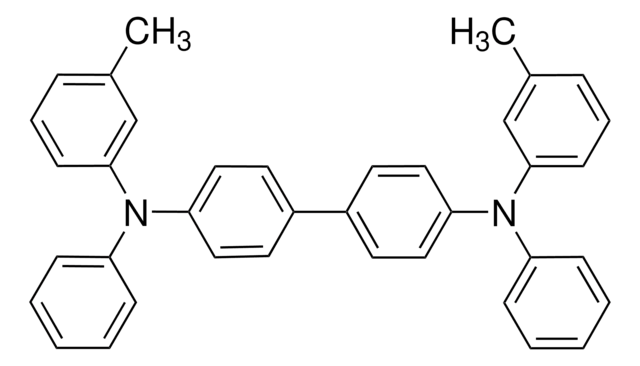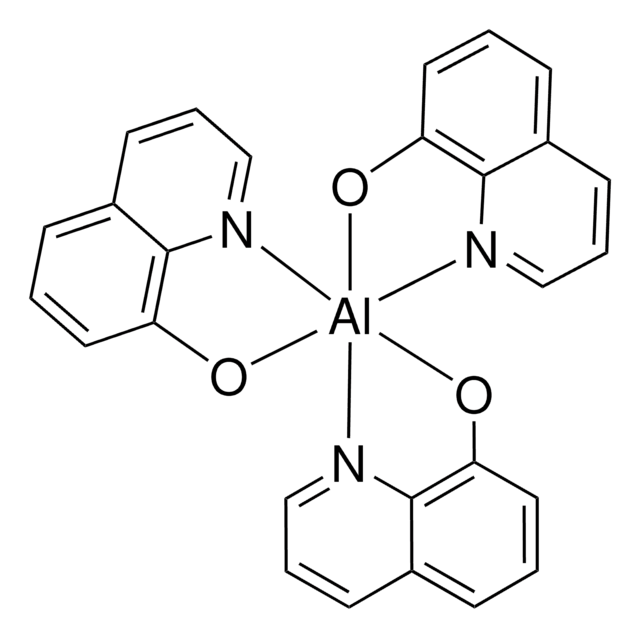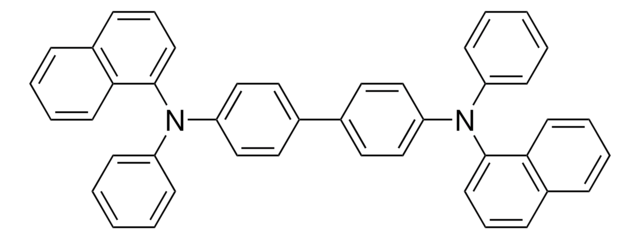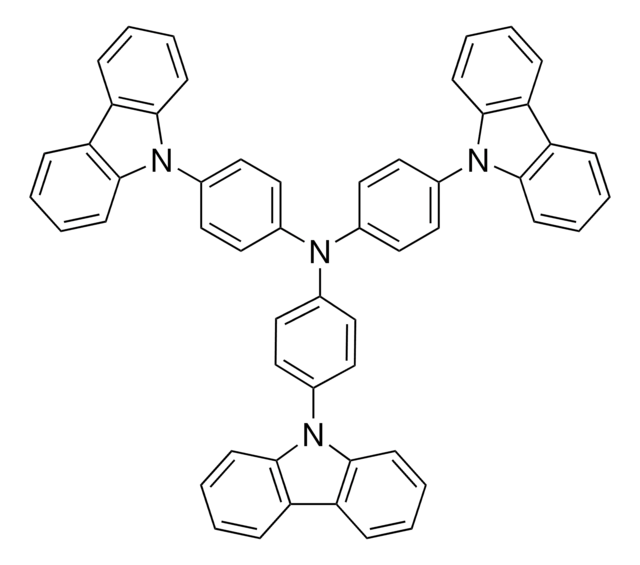556696
N,N′-Di(1-naphthyl)-N,N′-diphenyl-(1,1′-biphenyl)-4,4′-diamine
sublimed grade, 99%
Synonym(s):
N,N′-Bis(naphthalen-1-yl)-N,N′-bis(phenyl)benzidine, NPB, NPD
About This Item
Recommended Products
grade
sublimed grade
Assay
99%
loss
0.5 wt. % loss on heating, 345°C (typical, TGA)
mp
279-283 °C (lit.)
Orbital energy
HOMO 5.5 eV
LUMO 2.4 eV
OLED Device Performance
ITO/NPD/TCTA/BCPO:Ir(piq)3 (7-8%)/BCP/Alq3/LiF/Al
ITO/NPD/TCTA/BCPO:Ir(ppy)3 (7-8%)/BCP/Alq3/LiF/Al
ITO/NPD/mCP/BCPO:FIrpic (8%)/TAZ/LiF/Al
ITO/PEDOT:PSS/NPD/TCTA/m-CBTZ:Ir(Bt)2(acac) (10%)/TPBI/LiF/Al
SMILES string
c1ccc(cc1)N(c2ccc(cc2)-c3ccc(cc3)N(c4ccccc4)c5cccc6ccccc56)c7cccc8ccccc78
InChI
1S/C44H32N2/c1-3-17-37(18-4-1)45(43-23-11-15-35-13-7-9-21-41(35)43)39-29-25-33(26-30-39)34-27-31-40(32-28-34)46(38-19-5-2-6-20-38)44-24-12-16-36-14-8-10-22-42(36)44/h1-32H
InChI key
IBHBKWKFFTZAHE-UHFFFAOYSA-N
Looking for similar products? Visit Product Comparison Guide
Related Categories
General description
Application
Storage Class Code
11 - Combustible Solids
WGK
WGK 3
Flash Point(F)
Not applicable
Flash Point(C)
Not applicable
Personal Protective Equipment
Certificates of Analysis (COA)
Search for Certificates of Analysis (COA) by entering the products Lot/Batch Number. Lot and Batch Numbers can be found on a product’s label following the words ‘Lot’ or ‘Batch’.
Already Own This Product?
Find documentation for the products that you have recently purchased in the Document Library.
Articles
The soaring global demand for energy has created an urgent need for new energy sources that are both cost-competitive and eco-friendly.
Plexcore® organic conductive inks are electronic grade inks formulated for use in the hole injection layers of OLEDs.
Sublimed materials for organic electronic devices such of OFETs and OTFTs allow the achievement of better electronic properties, and may help increase a device’s lifetime.
In this article, we demonstrate that bis-styrylbenzene derivatives show promising characteristics for very low lasing thresholds and discuss the design considerations for organic lasing molecules.
Our team of scientists has experience in all areas of research including Life Science, Material Science, Chemical Synthesis, Chromatography, Analytical and many others.
Contact Technical Service





![Poly[2-methoxy-5-(2-ethylhexyloxy)-1,4-phenylenevinylene] average Mn 40,000-70,000](/deepweb/assets/sigmaaldrich/product/structures/344/488/b8f8179d-3970-4deb-a754-adda88cdb36f/640/b8f8179d-3970-4deb-a754-adda88cdb36f.png)
![4,4′,4′′-Tris[phenyl(m-tolyl)amino]triphenylamine 98.0%](/deepweb/assets/sigmaaldrich/product/structures/370/101/1022653f-ed3b-4991-a82c-269ad710b908/640/1022653f-ed3b-4991-a82c-269ad710b908.png)